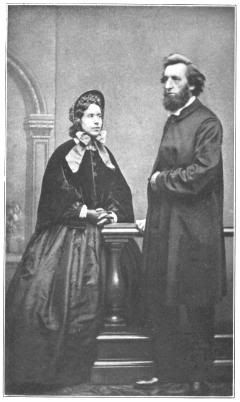Catherine Mumford was born in Ashbourne, Derbyshire, on 17 January 1829. From an early age she was a serious and sensitive girl. She had a strong Christian upbringing and by the age of 12 had read her Bible through eight times! But it was not until she was 16, after much struggling, that she was really converted. In her hymn book she read the words, “My God I am Thine, what a comfort Divine” (SASB 355), and realized the truth of this statement for herself.
At 14 she was seriously ill and spent a great deal of time in bed. But she kept herself busy, and was especially concerned about the problems of alcohol (her father became an alcoholic). She wrote articles for a magazine, which encouraged people not to drink.

She met William Booth when he came to preach at her church. They soon fell in love and became engaged. During three years of engagement, Catherine was a constant support to William in his tiring work of preaching, through her letters. At last on 16 June 1855, they were married. Unlike most weddings, theirs was very simple with no great expense. They wanted to use all their time and money for God. Even on their honeymoon, William found himself asked to speak at meetings. Together they accepted this challenge of being used by God before even thinking of themselves.
At Brighouse, Catherine first began to help in the work of the church. She was extremely nervous, but found the courage to speak in children’s meetings. She enjoyed working with young people. However it was unheard of for women to speak in adult meetings.In her world, women had few rights, no place in the professions and a minimal presence in church leadership.During her life, however, she would become one of the most popular preachers of her era.
Catherine was convinced that women had an equal right to speak. At Gateshead, when the opportunity was given for public testimony, she went forward to speak! It was the beginning of a tremendous ministry, for people were greatly challenged by her preaching.In her marriage to William Booth, she became an evangelist, preacher and theologian, and co-founder of The Salvation Army.
Catherine found the courage to speak to people in their homes, and especially to alcoholics whom she helped to make a new start in life. Often she held cottage meetings for converts.She was also a mother with a growing family of eight children and was dedicated to giving them a firm Christian knowledge. Two of them became Generals of The Salvation Army.
In 1865 when the work of The Christian Mission began William preached to the poor and ragged, and Catherine spoke to the wealthy, gaining support for their financially demanding work. In time she began to hold her own campaigns.When William Booth became known as the General, Catherine was known as the ‘Army Mother’. She was behind many of the changes in the new movement, designing a flag, bonnets for the ladies and contributing to the Army’s ideas on many important issues and matters of belief.
A prolific writer, Catherine explored universal questions and provided forthright answers. She believed Christians must be passionate about their faith, that if we are indifferent we can lose the capacity for love and service. She wrote: “He doesn’t ask you to go to chapel or join the church and pray…but to get down and give up your heart to Him, to choose whom you will serve, and do it at once, and everything else will follow.”
When died in 1890 it was a great loss. Her life had been a challenge to thousands who remembered her as an untiring soldier in God’s Army.In William Booth, Founder of The Salvation Army, Harold Begbie writes:
So passed away one of the most remarkable women of the nineteenth century, whose beautiful spirit impressed itself alike upon the most exacting of her intellectual contemporaries and upon vast masses of the poor. The development of her personality in conjunction with that of her husband is a most interesting study in psychology, and the growth of her spiritual power seems to me like one of the miracles of religious history.

(Compiled and edited from the International Heritage Centre Website and the USA National Headquarters Website)